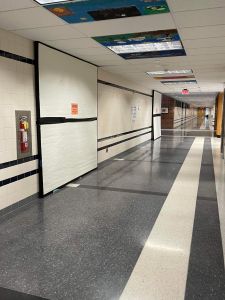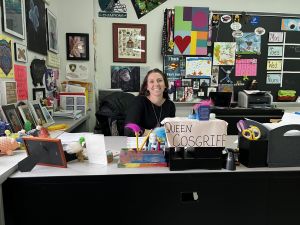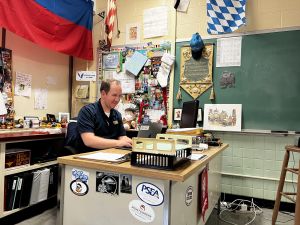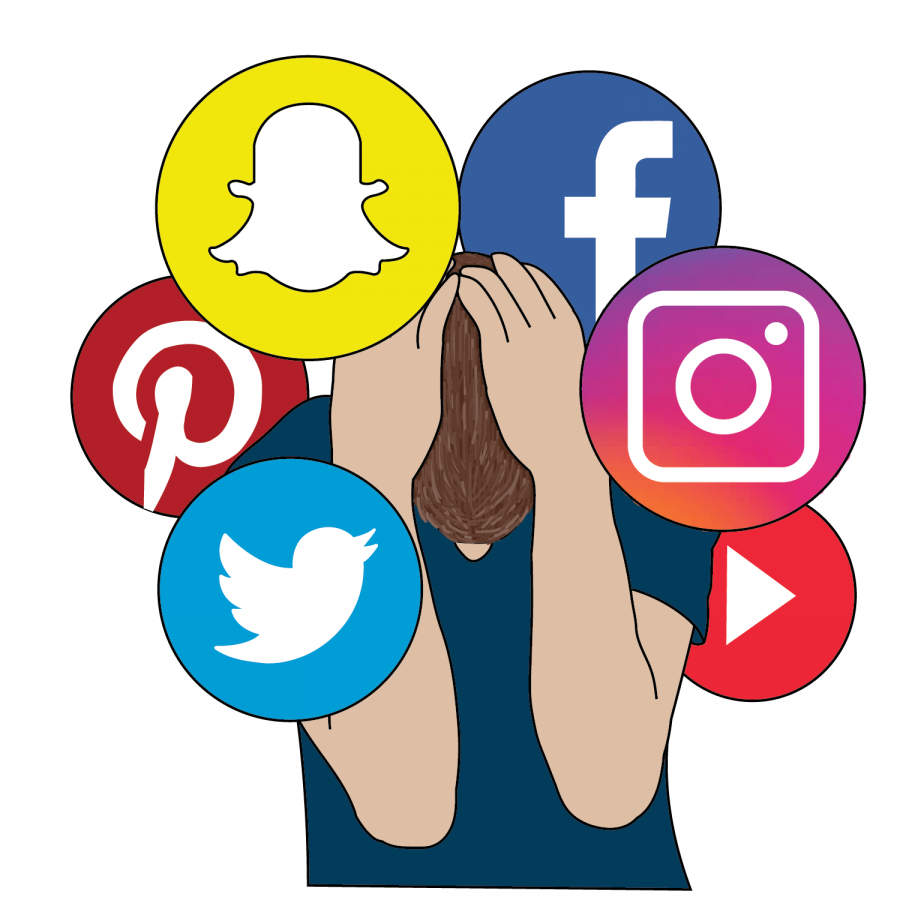Melissa Cosgriff, a fifth-grade math teacher at Upper Merion Area High School for 15 years, walked through the hallways on her lunch break. She found herself in an eighth-grade science teacher’s room, discussing a former student interviewing her about how social media is affecting students and teachers. His first response? “So you talked to her about all of the fights right?”
The Wall Street Journal found that school districts across the country are experiencing higher rates of misbehavior and violence as students return to in-person learning.
“I genuinely love my job. I thoroughly enjoy being here,” Cosgriff said. “Every day I wake up and am excited to go to work. I love it because it’s different every day, good or bad. The kids make it exciting, their personalities are fun. I still have the same mentality, but it’s a little bit different because there’s a lot outside going on that’s coming into the classroom. That’s always been a thing, it’s just very different now. COVID didn’t help and the kids are exposed to a lot more things.”
A few weeks ago, Cosgriff found herself in a funk, unsure if she could continue teaching anymore due to all of the outside factors coming into the middle school.
“We have 1300 students here. About 88 percent of them do the right thing,” Cosgriff said. “Most of these kids do the right thing every day and they want to be at school. I couldn’t let my focus get on those kids that are not doing the right thing and making it a bad day or a negative experience. Those kids that are doing the right thing need people and need someone to be there everyday. It’s hard though too because you want to reach those other kids that might need that extra bit of encouragement or attention. It’s a weird balance, it’s a weird struggle.”
Cosgriff described being grateful for not having social media when she was in school and has experienced the most struggle with Tik Tok and the ‘school challenges.’
“Some of these challenges included destroying the bathroom like ripping off the soap and paper towel dispensers and recording it,” Cosgriff said. “You can’t even go into the bathroom without worrying about kids clogging all the toilets or sinks with paper towels.”
One of the challenges also included fighting. Part of the challenge was to make sure a video was recorded and posted.
“Kids would go into the bathroom and actually stage fights,” Cosgriff said. “Someone would start filming as kids are premeditating their fight, saying ‘ok, I’m going to punch and/or kick you here.’ It was clear it was staged but they were getting out of control. Someone would get hit or kicked harder than they thought they should have so now they’re actually fighting. Kids were getting hurt.”
Fighting wasn’t just happening in the school, it continued on the buses. Buses have become crowded due to a lack of bus drivers and the fights that happened on the bus were actual altercations, not staged. From what Cosgriff knows, most started over gossip or ‘I heard you were talking about me’ drama.
“10 years ago, if this happened, kids’ first instincts weren’t to yank somebody’s hair and pull them to the ground,” Cosgriff said. “No one just wants to sit and talk about problems anymore. Kids are kids and they aren’t changing, it’s the world around them that’s changing.”
A lot of her students don’t want to ride the bus because they’re scared, due to both the fighting and rude comments. Their parents now take them to school and pick them up. The principals get on the bus and talk to the students and they try to do everything they can.
“That’s when I started thinking about my own three boys at home and my oldest is going to be in middle school next year,” Cosgriff said. “Is this what he’s going to be exposed to? Maybe I need to stay at home. Maybe I need to stay home and drive him to school if there’s fights like this on his buses. Do I need to go and take care of my family first and figure out another plan?”
In the past, middle school students had their phones on them often and were filming and taking photos of other students, which not all of them liked, leading to a physical altercation.
“The number of fifth graders involved in Tik Tok and Snapchat blows my mind,” Cosgriff said. “We did take cellphones away in middle school. That was one of the solutions to the fighting issues. We also had about 12 sets of girl/boy bathrooms but we are down to two. They are barricaded by a makeshift wall and fifth and sixth graders use the bathrooms in the back of the building and seventh and eighth graders have to use the ones in the front of the building and a security guard sits outside at a desk.”

“I’ve found that a lot of my kids are afraid to go to the bathroom now so I’ve been walking them upstairs to use it. Every teacher does it differently but this is what I can do so they’re not afraid to go to the bathroom.”
Ever since the bathrooms were shut down, there haven’t been any altercations in the remaining bathrooms. The community was upset about the bathrooms being shut down the way they were, thinking the school was punishing the whole school for a couple of kids fighting.
“I believe that if you change nothing, nothing will change. Something had to be done. We couldn’t let the fighting continue,” Cosgriff said.
Upper Merion Middle School is now a cellphone-free zone. When students walk in the door, their cellphone is expected to go into their book bag and their book bags have to stay in their lockers. The school wasn’t using lockers during COVID, resulting in more cellphone use.
“As a teacher, your instinct is to break up a fight,” Cosgriff said. “But some kids would say, ‘You’re not allowed to touch us, I’m filming you.’ Then all of a sudden as a teacher, what do you do? I know my principal would back me up and say that I was trying to do the right thing but these are things we have to think about during the moment.”
Students within the school created social media pages such as ‘umfights’ then would change it by adding a period or another symbol. Students thought teachers wouldn’t catch on and find the new pages even though it’s easy for them to do.
“This just messes with you mentally. Your mental and emotional frame of mind is very different,” Cosgriff said. “Before closing the bathrooms and taking away the phones, I used to hope that I wouldn’t have to be near a fight. I had some colleagues laugh at me for this but I brought a whistle to school. If I come across a fight of two eighth-grade boys fighting who are a foot taller than me, would I be able to break that up? I don’t know. The whistle would make them stop fighting while also getting someone else’s attention.”
Upper Merion Middle School has had four expulsions this year and multiple suspensions. Cosgriff described the place she’s been coming to for 15 years always having a very positive feel to it but then this year happened and she worries about the future, not only for kids, but for community members and parents as well.
“The accountability is not the same for the kids,” Cosgriff said. “If you would have asked me 10 years ago about my engagements with parents, I would have said they’re great. More and more each year, the finger has been getting pointed back at the teacher or back at the school as if we’re doing something wrong because of the ‘oh, not my kid, my kid would never do that’ mentality. They think we’re making things up. Believing the kid over the teacher was not the way growing up.”
Despite Cosgriff noticing that there are teachers out there who are not the most honest, it’s something that can be seen with any profession. She found that she and other teachers second guess what they’re supposed to do and many are getting worn-out because of this, even though they’re trying their hardest.
“Parents need to be a team with the school and acknowledge that their kid isn’t perfect. If a teacher calls home and says something happened, they need to believe it,” Cosgriff said.
What the middle school is doing to help make change is having more teachers in the hallway between class times, talking about the consequences of actions every day and despite students having access iPads that they use during their classes and also take home to complete homework, Cosgriff doesn’t like using them as she finds that kids aren’t interacting with each other.
To help make social interactions a better experience, she created ‘Parfy.’ It’s a made-up word that stands for ‘Picking Activities Right For You.’ Students get 30 minutes of ‘Parfy’ time where they get to pick a board game or a card game and have a face-to-face interaction with someone else.

“I only oversee, I let them figure out what should be done if something doesn’t go as planned,” Cosgriff said. “If someone doesn’t pull the Jenga piece right, do they want to restart? Are they going to let it go? Do they miss a turn? I want them to be able to solve their problems verbally rather than through technology or even violence.”
“There’s so much violence surrounding them in the world, and I doubt my fifth graders watch the news, but they see it on the social media that they’re exposed to and they think it’s okay.”
Cosgriff has always had an adoration for Will Smith. She would even devote a lesson plan in the beginning of every school year to getting to marry him, despite already having a husband. She drew on what happened with him and Chris Rock at the Oscars as a prime example of what children are being exposed to.
“Some of these kids only saw him [Smith] hitting Chris Rock and so they think it’s okay to walk up to someone and hit them in the face if you’re mad at them. That’s what they do right now,” Cosgriff said. “Some of them have said, ‘if Will Smith can do it, why can’t I?’”
Melaine Gogarty, a teacher at Upper Merion High School for 19 years, has been experiencing similar issues this school year. The high school has been subject to vandalism, such as sinks being ripped off the walls due to the Tik Tok ‘challenges’, and teachers being hit from the rear.
“That was scary. We actually got an email about how to protect ourselves. It was ridiculous that we had to deal with that,” Gogarty said.
The high school also faces an issue with fighting, as one student had to be removed by an ambulance recently. Gogarty finds that social media has a huge role in these fights due to the drama and backstabbing happening on the platforms that gets built up overnight and then dragged into school.
“When I grew up, we got to go home and have our space away from friends and socializing and drama,” Gogarty said. “With social media, these kids are so involved and it’s constant. There’s no down time, family time or an escape. With the isolation of the pandemic and now being in social settings, some of these kids have missed the formative years of the transition between middle school and high school. They haven’t had to deal with drama.”
Drama often is talked about face to face in the high school bathrooms, resulting in the “regular” kids being unable to use the bathroom since they can’t find one that’s not being used for some interaction.
Gogarty has also struggled with backlash from the community and family members.
“Our names get dragged through their opinions,” Gogarty said. “It’s been taxing and it’s made me and a lot of other teachers reconsider our job. We’re out there so much more, it’s scary to think about how we have to protect ourselves. There are community pages where people blast the teachers and the school district by taking their limited knowledge instead of talking to sources. My life’s work has been about helping the marginalized and trying to make the school district a better place. There is a lot that we do here that people aren’t aware of.”
Both Upper Merion Middle School and Upper Merion High School have a PBIS system in place, meaning Positive Behavior Intervention and Support. It acts as a positive reinforcement system to help with the negative reactions students are having.
“With PBIS, we’ve done lesson plans on what being ready and on time look like,” Gogarty said. “We have these surprise ticket awards and at the start of class, the assistant principal hops on the loudspeaker and says ‘anyone who is on time and ready, teachers can give them a ticket and they can enter into a drawing for a prize.’”
The school district also enforces restorative practices where the idea of having relationships with kids in and out of the classroom is important.
The high school has increased the number of therapists and counselors, security staff and increased teacher presence in the hallway, “not simply for discipline but to just be there and check-in.” They also participate in child study. Administrators meet once a week to talk about specific cases and when students have reached maximum disciplinary issues, they talk about what could be done to help that student.
“The last resort is out placing them. A lot of the out placement schools are full because of all these reasons [fighting, social media, etc.],” Gogarty said.
UMHS has a student assistance program where they look out for those with mental health and addiction problems. There is then confidential outreach to parents/whoever is involved in a child’s life as to how they can help. There is also IST (Instructional Support Team) where they help students who have lost their way with academics. With a mentor program in place as well, teachers volunteer and check-in with students. The National Honor Society has student volunteers who help out too.
“Each step of the way there’s effort. We’re trying to make things more normal,” Gogarty said. “There’s a lot of stuff that goes on behind the scenes to be there and be a face for kids and offer help and assistance.”
As a fellow teacher, Gogarty explained that they have been there for each other to reward each other and make each other laugh during the hard times. When it comes to helping children, she tries to give them as much feedback as possible. On the first of each month, teachers are supposed to do a “social emotional learning” activity.
“It’s encouraged in the classroom as much as possible and it’s encouraged for the teachers. It’s not required, but the more we can do, the better, so that people have a chance to decompress and focus on themselves,” Gogarty said. “I’ve had kids color, play games and other teachers do social emotional learning lessons. Others tell their students to take the day and work on anything they have to work on since there’s a stressor for a lot of students.”
Gogarty described one of her favorite and most fun activities being a rubber band war with her co-teacher and students.
“Being real for the kids and giving the kids a chance to feel that too is something I’ve been working on a lot more,” Gogarty said.
Jeffery Skonier, a German teacher at Upper Merion High School for 20 years, thinks that COVID had a tremendous amount to do with the ongoing problems within the district.

“I think when COVID hit, that changed the dynamic,” Skonier said. “Now you have kids at home who are sitting in front of a computer screen the whole time. It’s so easy for them to turn their camera off and be on their phone. They’re half zoning into the class and not paying attention. This isn’t every student but it affected a lot of them so much that when we came back to in person learning, a lot of them almost forgot how to learn and how to be in a classroom.”
He described that, this year, both ninth and tenth graders were in the transition period of coming from the middle school to the high school, and due to their lack of interaction with other students because of the pandemic, fights and disagreements built up within the school.
“They weren’t having to wait for another student to answer, they weren’t having to raise their hands. That whole classroom culture wasn’t really happening in the virtual world,” Skonier said. “I think a lot of them forgot how to interact and be present in a classroom. A lot of kids have lost that skill and that ability.”
“You find that sometimes you’re trying to get the kids to get along emotionally in the classroom more than teaching the subject or material. It can be taxing on certain teachers who are doing that all of the time.”
Skonier believes there are students that try to avoid certain areas if they know that’s a heavily congested area where kids get into issues or a spot where a lot of fights or disagreements happen.
Because of COVID, the lunch period is meant to be held in both the cafeteria and auditorium. However, students find themselves in other areas of the building, which seems to cause trouble.
“Some kids will eat in the upper commons space or the library and there’s kids moving around more than they were in the school day and I think that gives kids a chance to interact sometimes in a negative way,” Skonier said. “If kids were having an issue, they could provoke someone else in the hallways when they know they’re in passing. When they didn’t have this freedom to roam the building, it wasn’t as much of an issue.”
Skonier acknowledges the ever-growing student population and how it’s on the school to make sure these kids are accepted.
In 2000, there were a total of 991 students enrolled at Upper Merion High School. Of that 991, 820 were white, 68 were African American, 86 were Asian and 17 were Hispanic. In 2021, 1238 attended UMHS. 668 were white, 175 were Asian, 170 were African American, 154 were Hispanic, 66 were of two or more races and five were American Indian.
“Our school is changing. Our student body is changing. When I started, we had different types of students,” Skonier said. “Now we have students of different types of socio-economic statuses, ethnicities and I think we as a school district have to be changing with the times to make sure all kids feel welcome. If the school is still acting like they were 20 years ago, the new set of students coming in won’t feel accepted and I think we had a little bit of that here. I think if we make sure the school is welcoming to all of those kids, we’ll see less of the anger, frustration, animosity and things like that.”
Assistant professor in teacher education, Dr. Zakia Gates and assistant professor in education, Dr. Amber Gentile both acknowledge the impact social media has on both students and professor. However, the challenges may not be the same at the college level.
“I have not seen the Tik Tok challenges being as much of an issue as it has been in the K-12 education system,” Gentile said. “It is truly unfortunate that social media has become another way to bully and/or encourage negative actions. I know that teachers have been negatively impacted by them as well as the students. It is a difficult aspect to handle and they do not feel prepared to do so. It does not align with their passion for teaching.”
Gentile described at the college level, she has had students express feelings of pressure in terms of what they see on social media while also experiencing FOMO (fear of missing out) because they see constant messaging of what everyone is doing.
“These feelings of uncertainty, anxiety, and overwhelm are not conducive to overall wellness or to learning,” Gentile said.
Gentile and Gates advise students to use the resources available on campus to talk with others, like the counseling center. Gates would also like to see students create spaces for themselves via social media which are “geared to help instead of hinder.”
“What I would like to see is a world where more people use the moral compass that they are born with and to treat others with the respect that we all deserve,” Gates said. “I would love to live in a world where people don’t use race, gender, class, age, etc as a guide to respect each other. Just respect each other as human beings.”



